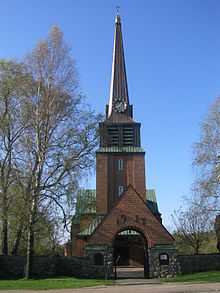Oskarström
| Oskarström | |
|---|---|
 Oskarström | |
| Coordinates: 56°48′5.601″N 12°58′34.503″E / 56.80155583°N 12.97625083°ECoordinates: 56°48′5.601″N 12°58′34.503″E / 56.80155583°N 12.97625083°E | |
| Country | Sweden |
| Province | Halland |
| County | Halland County |
| Municipality | Halmstad Municipality |
| Area[1] | |
| • Total | 3.49 km2 (1.35 sq mi) |
| Population (31 December 2010)[1] | |
| • Total | 4,071 |
| • Density | 1,166/km2 (3,020/sq mi) |
| Time zone | CET (UTC+1) |
| • Summer (DST) | CEST (UTC+2) |
Oskarström is the second largest locality in Halmstad Municipality, Halland County, Sweden, with 4,071 inhabitants in 2010.[1] It is situated along the river Nissan about 15 km north-east of Halmstad.
Oskarström has its name from Oscar Björkman from Gothenburg, who in 1844 bought land here and erected a sawmill.
The local bandy club is called Oskarströms BK.
History
Prehistory
During the Iron Age in current Vrenninge there was a settled farming population. As evidence of this, there are village grave fields with Iron Age dolmen, a stone circle and a trident. The villages Mared and Espered were probably founded in the early Middle Ages and were approximately equal up to the mid-1880s. During the Nordic Seven Years' War (1563-1570) the Swedes led by commander Charles de Mornay fought against the forces of the Danish King Frederick II at the Battle of Mared, which stood where the present Oskarström now located. In memory of this the Halland Museum Association erected a memorial stone in 1923.
The society Oskarström
The name Oskarström is not named after the Swedish kings Oscar I or Oscar II but bookkeeper Oscar Bjorkman who was born in Ulricehamn and who in 1844, bought a piece of land with waterfalls by the Nissan River. He built a sawmill on the property, which he named after himself - Oscarsström. In 1850, when the location's name was written in Halland County newspaper, it was Oskarsström.
In 1885, Oscarström was purchased by Isaac Andrew and Carl Wilhelm Wallberg and they established a hat factory in 1886, which employed hundreds from the district until 1888, when the factory was moved down to Wallenberg AB in Halmstad.
In 1890, the Oskar Ströms Jutefabrik started, after just nine months of construction. This was the foundation of the modern industrial society. On January 27, 1905, Oskarströms municipal society was founded on both sides of the border, between the parishes Enslöv and Slättåkra, as of May 15, 1936 spelled Oskarström. In 1947 it was broken out of Enslöv and Slättåkra municipalities and formed Oskarström market town, Halland's first and only market town. The ecclesiastical division between Enslöv and Slättåkra continued until 1957 when Oskarström's congregation was formed. Since 1974, it has been part of the Municipality of Halmstad.
References
- ↑ 1.0 1.1 1.2 "Tätorternas landareal, folkmängd och invånare per km2 2005 och 2010" (in Swedish). Statistics Sweden. 14 December 2011. Archived from the original on 10 January 2012. Retrieved 10 January 2012.


| |||||